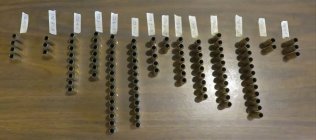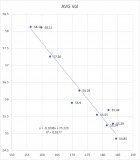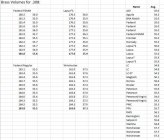Like some of the other responders, I've determined case volumes using water and plotted them versus case weight for years. I do this using relatively small numbers of cases, usually 10 at a time, for the purpose of determining an average case volume for use with QuickLoad. Those that wish to believe that case weight has little to no relation to case volume have clearly
not done this themselves. In fact fact, I have tested Lapua, Alpha, Norma, Nosler, Starline, Remington, PPU, and Federal brands, in at least three different cartidges, and they all exhibit a strong [inverse] linear correlation between case weight and case volume. That is to say, as case weight increases, case volume decreases.
This correlation makes sense, as the only places on a fired case that has expanded fully in the chamber where the amount of brass (i.e. weight) might not directly correlate to some change in internal volume are the primer pocket and the extractor groove. In my experience, the extractor grooves within a single Lot# of brass do not vary noticeably, as they shouldn't. Current technology is more than up to the task of cutting a uniform extractor groove within a single Lot# of brass. Likewise, if the primer pocket diameter wasn't reasonably consistent, the primers either might not fit in the primer pocket, or might fall right out. We all know this isn't the case either, as there isn't much room for error in terms of primer pocket diameter. Primer pocket
depth can clearly vary, but it's generally not by huge amounts, and I prepare the primer pockets with a uniforming tool, anyhow.
One tool to estimate how well the data points fit a straight line plot is Pearson's Correlation Coefficient (r), which is sometimes also reported by graphing programs as r^2, such that r^2 will always have a positive value between 0 and 1. The closer the value of r (or r^2) to 1, the better the linear correlation. Correlation coefficients greater than 0.5 indicate a linear correlation, and those greater than about 0.75 indicate a strong linear correlation. For example, the value of r^2 for the data plotted in post #27 above by
@Doom is 0.9277, indicating a very strong linear correlation between case weight and case volume. With such a solid data set, most don't need the correlation coefficient to tell them the data represent a linear function; their eyes can do that. Nonetheless, it is also clear that there are a few points that are slight outliers and do not fall directly on the best line approximation.
What can be taken from this is that using case weight as a surrogate for case volume is not
perfect. Nonetheless, it is also clear that cases sorted by weight as a surrogate for volume will generally have less volume variance than than if nothing was done at all. And that's what we're really after as shooters with any sorting process we might use, isn't it? We can sort things and thereby reduce variance, which we hope translates better precision on the target. None of the sorting techniques we use are
perfect. It would be asking too much for that to be true. But we can sort things into "like" sub-groups and make them more consistent than they would be if nothing were done. For that purpose, sorting cases by weight simply works, and it is far easier and less time consuming than determining water volume. Frankly, I typically like to have 300-400 pcs of brass dedicated to a single F-TR rifle, and I have multiple F-TR rifles that I shoot regularly. I would not attempt to sort thousands of cases using water volume measurements. In fact, if I had to do that I would probably quit shooting and take up knitting. Fortunately, sorting cases by weight is relatively painless as I generally sort them into "light", "medium", and "heavy" sorting groups, whose limits/ranges are determined from analysis of ~50-100 case weights.
Here are a few examples:
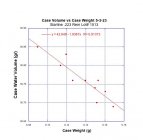
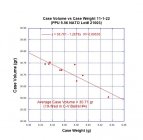
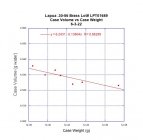
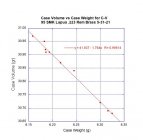
As can be seen, the r values indicate strong linear correlation for each data set. It is not unreasonable to infer from this that sorting case by weight will improve the volume consistency in sorted sub-groups. Like everything, whether doing so would be of benefit in a particular shooting discipline will have to be determined by the individual. In F-Class, we use relatively long strings of fire (20+ shots) and it is my belief that improving the consistency of case volume using case weight as a surrogate volume measurement can improve ES/SD over not sorting cases at all. So I do it. What I can state with absolute certainty is that sorting cases by weight will never cause case volume variance to
increase. So for me, it's worth the effort, but everyone has to make the decision whether the investment of time is worth the potential gain for themselves.
